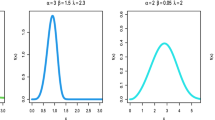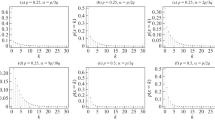Abstract
Statistical probability distributions are frequently used in real-world data analysis. However, data from fields such as environmental science, finance, and biomedical sciences may not always fit in classical distributions. This usually requires the development of new distributions that better reflect data behavior in a variety of situations. In this paper, we introduce a new four-parameter distribution termed the Harris extended inverted Kumaraswamy (HEIK) distribution is proposed and analyzed in detail. This generalization accommodates well-known submodels including MOEIK, GIK, EIK, IK and MOLL as observed in this study. The study includes the basic properties of the observed probabilistic model. Explicit expressions for major mathematical properties of this distribution such as quantile function, complete moments, incomplete moments, conditional moments, inverted moments, mean deviation, moment generating function, inequality measure, mean residual life and mean inactivity time are derived. The various entropy measures, extropy and order statistics are derived. The maximum likelihood estimation method is used to estimate the parameters. Simulation studies are conducted for different parameter values and compare the performance of the HEIK distribution. Three illustrative examples involving COVID-19 datasets from three countries are presented.











Similar content being viewed by others
Explore related subjects
Discover the latest articles and news from researchers in related subjects, suggested using machine learning.Data Availability Statement
Three datasets are contained within the article.
References
Ahsan-ul-Haq, M., Ahmed, M., Zafar, J., Ramos, P.L.: Modeling of COVID-19 cases in Pakistan using lifetime probability distributions. Ann. Data Sci. 9(1), 141–152 (2022). https://doi.org/10.1007/s40745-021-00338-9
Liu, X., Ahmad, Z., Gemeay, A.M., Abdulrahman, A.T., Hafez, E.H., Khalil, N.: Modeling the survival times of the COVID-19 patients with a new statistical model: a case study from China. PLoS ONE 16(7), 1–31 (2021). https://doi.org/10.1371/journal.pone.0254999
Pathak, A., Kumar, M., Singh, S.K., Singh, U.: Statistical inferences: based on exponentiated exponential model to assess novel corona virus (COVID-19) Kerala patient data. Ann. Data Sci. 9(1), 101–119 (2022). https://doi.org/10.1007/s40745-021-00348-7
Nagy, M., Almetwally, E.M., Gemeay, A.M., Mohammed, H.S., Jawa, T.M., Sayed-Ahmed, N., Muse, A.H.: The new novel discrete distribution with application on COVID-19 mortality numbers in Kingdom of Saudi Arabia and Latvia. Complexity 2021(1), 7192833 (2021). https://doi.org/10.1155/2021/7192833
Riad, F.H., Alruwaili, B., Gemeay, A.M., Hussam, E.: Statistical modeling for COVID-19 virus spread in Kingdom of Saudi Arabia and Netherlands. Alex. Eng. J. 61(12), 9849–9866 (2022). https://doi.org/10.1016/j.aej.2022.03.015
Dubey, S.D.: Compound gamma, beta and F distributions. Metrika 16(1), 27–31 (1970). https://doi.org/10.1007/BF02613934
Gh Voda, V.: On the inverse Rayleigh distributed random variable. Rep. Stat. Appl. Res. 19(4), 13–21 (1972)
Folks, J.L., Chhikara, R.S.: The inverse Gaussian distribution and its statistical application-a review. J. R. Stat. Soc. Ser. B Stat Methodol. 40(3), 263–275 (1978). https://doi.org/10.1111/j.2517-6161.1978.tb01039.x
Calabria, R., Pulcini, G.: On the maximum likelihood and least-squares estimation in the inverse Weibull distribution. Stat. Appl. 2(1), 53–66 (1990)
Sharma, V.K., Singh, S.K., Singh, U., Agiwal, V.: The inverse Lindley distribution: a stress-strength reliability model with application to head and neck cancer data. J. Ind. Prod. Eng. 32(3), 162–173 (2015). (https://api.semanticscholar.org/CorpusID:88520025)
Kumaraswamy, P.: A generalized probability density function for double-bounded random processes. J. Hydrol. 46(1–2), 79–88 (1980). https://doi.org/10.1016/0022-1694(80)90036-0
Jones, M.C.: Kumaraswamy’s distribution: a beta-type distribution with some tractability advantages. Stat. Methodol. 6(1), 70–81 (2009). https://doi.org/10.1016/j.stamet.2008.04.001
Pinho, L.G.B., Cordeiro, G.M., Nobre, J.S.: The Harris extended exponential distribution. Commun. Stat. Theory Methods 44(16), 3486–3502 (2015). https://doi.org/10.1080/03610926.2013.851221
Gholizadeh, R., Shirazi, A.M., Mosalmanza, S.: Classical and Bayesian estimations on the Kumaraswamy distribution using grouped and un-grouped data under difference loss functions. J. Appl. Sci. 11(12), 2154–2162 (2011). (https://scialert.net/abstract/?doi=jas.2011.2154.2162)
Sindhu, T.N., Feroze, N., Aslam, M.: Bayesian analysis of the Kumaraswamy distribution under failure censoring sampling scheme. Int. J. Adv. Sci. Technol. 51, 39–58 (2013). (https://api.semanticscholar.org/CorpusID:18457909)
El-Deen, M.M., Al-Dayian, G.R., El-Helbawy, A.A.: Statistical inference for Kumaraswamy distribution based on generalized order statistics with applications. Br. J. Math. Comput. Sci. 4(12), 1710–1743 (2014). https://doi.org/10.9734/BJMCS/2014/9193
Iqbal, Z., Tahir, M.M., Riaz, N., Ali, S.A., Ahmad, M.: Generalized inverted Kumaraswamy distribution: properties and application. Open J. Stat. 7(4), 645–662 (2017). https://doi.org/10.4236/ojs.2017.74045
Abd AL-Fattah, A.M., El-Helbawy, A.A., Al-Dayian, G.R.: Inverted Kumaraswamy distribution: properties and estimation. Pak. J. Stat. vol. 33, no. 1, (2017)
Aly, E.-E.A.A., Benkherouf, L.: A new family of distributions based on probability generating functions. Sankhya B 73, 70–80 (2011). https://doi.org/10.1007/s13571-011-0017-9
Harris, T.E.: Branching processes. Ann. Math. Stat. pp. 474–494, (1948)
Ashkar, F., El Adlouni, S.: Correcting confidence intervals for quantiles of a heavy-tailed distribution: case of the two-parameter Kappa distribution. J. Hydrol. 512, 498–505 (2014). https://doi.org/10.1016/j.jhydrol.2014.03.025
Li, C., Singh, V.P., Mishra, A.K.: A bivariate mixed distribution with a heavy-tailed component and its application to single-site daily rainfall simulation. Water Resour. Res. 49(2), 767–789 (2013). https://doi.org/10.1002/wrcr.20063
Ogunde, A.A., Laoye, V.E., Ezichi, O.N., Balogun, K.O.: Harris extended power Lomax distribution: properties, inference and applications. Int. J. Stat. Probab. 10(4), 77–95 (2021). https://doi.org/10.5539/ijsp.v10n4p77
Thomas, S.P., Tomy, L., Jose, K.K.: Harris extended two parameter Lindley distribution and applications in reliability. Reliab. Theory Appl. 16(63), 302–321 (2021)
Tomy, L., Veena, G., Chesneau, C.: A new three-parameter lifetime distribution for environmental data analysis: the Harris extended modified Lindley distribution. Int. J. Data Sci. Anal. 5, 1–16 (2024). https://doi.org/10.1007/s41060-024-00505-0
Usman, R.M., Ul Haq, M.A.: The Marshall-Olkin extended inverted Kumaraswamy distribution: theory and applications. J. King Saud Univ. Sci. 32(1), 356–365 (2020)
Gradshteyn, I.S., Ryzhik, I.M.: Table of Integrals, Series, and Products. Academic Press, New York (2014)
Almetwally, E.M., Alharbi, R., Alnagar, D., Hafez, E.H.: A new inverted Topp-Leone distribution: applications to the COVID-19 mortality rate in two different countries. Axioms 10(1), 25 (2021). https://doi.org/10.3390/axioms10010025
Almongy, H.M., Almetwally, E.M., Aljohani, H.M., Alghamdi, A.S., Hafez, E.H.: A new extended Rayleigh distribution with applications of COVID-19 data. Results Phys. 23, 104012 (2021). https://doi.org/10.1016/j.rinp.2021.104012
Fatima, K., Jan, U., Ahmad, S.P.: Statistical properties and applications of the exponentiated inverse Kumaraswamy distribution. J. Reliab. Stat. Stud. 11(2), 93–102 (2018)
Gui, W.: Marshall-Olkin extended log-logistic distribution and its application in minification processes. Appl. Math. Sci. 7(77-80), 3947–3961, (2013). https://doi.org/10.12988/ams.2013.35268
Suleiman, A.A., Daud, H., Ishaq, A.I., Othman, M., Sokkalingam, R., Usman, A., Osi, A.A.: The odd beta prime inverted Kumaraswamy distribution with application to COVID-19 mortality rate in Italy. Eng. Proc. 56(1), 218 (2023). https://doi.org/10.3390/ASEC2023-16310
Hassan, A.S., Almetwally, E.M., Ibrahim, G.M.: Kumaraswamy Inverted Topp-Leone Distribution with Applications to COVID-19 Data. Comput. Mater. Continua 68(1), (2021). https://doi.org/10.32604/cmc.2021.013971
El-Helbawy, A.A., Hegazy, M.A., Al-Dayian, G.R., Abd EL-Kader, R.E.: A discrete analog of the inverted Kumaraswamy distribution: properties and estimation with application to COVID-19 data. Pak. J. Stat. Oper. Res. 18(1), 297–328, (2022). https://doi.org/10.18187/pjsor.v18i1.3634
Opone, F., Karakaya, K., Ubaka, N.: Statistical Analysis of COVID-19 Data using the Odd Log Logistic Kumaraswamy Distribution. Stat. Optim. Inf. Comput. 12(1), 210–230 (2024). https://doi.org/10.19139/soic-2310-5070-1572
Shannon, C.E.: A mathematical theory of communication. Bell Syst. Tech. J. 27, 379–423 (1948). https://doi.org/10.1002/j.1538-7305.1948.tb01338.x
Rényi, A.: On measures of entropy and information. Proc. Fourth Berkeley Symp. Math. Stat. Probab. vol. 1, pp. 547–561, (1960)
Campbell, L.L.: Exponential entropy as a measure of extent of a distribution. Z. Wahrscheinlichkeitstheorie verw. Gebiete 5, 217–225 (1966). https://doi.org/10.1007/BF00533058
Tsallis, C.: Possible generalization of Boltzmann-Gibbs statistics. J. Stat. Phys. 52, 479–487 (1988). https://doi.org/10.1007/BF01016429
Havrda, J., Charvát, F.: Quantification method of classification processes, concept of structural a-entropy. Kybernetika 3, 30–35 (1967)
Arimoto, S.: Information-theoretical considerations on estimation problems. Inf. Control 19, 181–194 (1971). https://doi.org/10.1016/S0019-9958(71)90065-9
Lad, F., Sanfilippo, G., Agrò, G.: Extropy: complementary dual of entropy. Statist. Sci. 30, 40–58 (2015). https://doi.org/10.1214/14-STS430
Agosto, A., Campmas, A., Giudici, P., Renda, A.: Monitoring COVID-19 contagion growth. Statist. Med. 40(18), 4150–4160 (2021). https://doi.org/10.1002/sim.9020
Bussmann, N., Enzmann, R., Giudici, P., Raffinetti, E.: Shapley-Lorenz values for credit risk management. In Proc. Sci. Meet. Classification Data Anal. Group Ital. Stat. Soc. pp. 121–132, (2021). https://doi.org/10.1007/978-3-031-30164-3_10
Batsidis, A., Lemonte, A.J.: On the Harris extended family of distributions. Statist. 49(6), 1400–1421 (2014). https://doi.org/10.1080/02331888.2014.969732
Cerchiello, P., Giudici, P.: Big data analysis for financial risk management. J. Big Data, 3(18), (2016). https://doi.org/10.1186/s40537-016-0053-4
Giudici, P., Raffinetti, E.: Explainable AI methods in cyber risk management. Qual. Reliab. Eng. Int. 38(3), 1318–1326, (2022). https://doi.org/10.1002/qre.2939
Giudici, P., Mezzetti, M., Muliere, P.: Mixtures of products of Dirichlet processes for variable selection in survival analysis. J. Stat. Plan. Inference 111(1–2), 101–115 (2003). https://doi.org/10.1016/S0378-3758(02)00291-4
Foss, S., Korshunov, D., Zachary, S.: Heavy-tailed and long-tailed distributions. An Introduction to Heavy-Tailed and Subexponential Distributions, pp. 7–42, (2013). https://doi.org/10.1007/978-1-4614-7101-1_2
Klüppelberg, C.: Subexponential distributions and integrated tails. J. Appl. Probab. 25(1), 132–141 (1988). https://doi.org/10.2307/3214240
Funding
The author received no specific funding for this study.
Author information
Authors and Affiliations
Corresponding author
Ethics declarations
Conflict of interest
The authors declare that they have no conflict of interest.
Additional information
Publisher's Note
Springer Nature remains neutral with regard to jurisdictional claims in published maps and institutional affiliations.
Rights and permissions
Springer Nature or its licensor (e.g. a society or other partner) holds exclusive rights to this article under a publishing agreement with the author(s) or other rightsholder(s); author self-archiving of the accepted manuscript version of this article is solely governed by the terms of such publishing agreement and applicable law.
About this article
Cite this article
Bengalath, J., Punathumparambath, B. Harris extended inverted Kumaraswamy distribution: Properties and applications to COVID-19 data. Int J Data Sci Anal (2024). https://doi.org/10.1007/s41060-024-00639-1
Received:
Accepted:
Published:
DOI: https://doi.org/10.1007/s41060-024-00639-1




